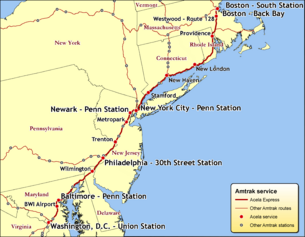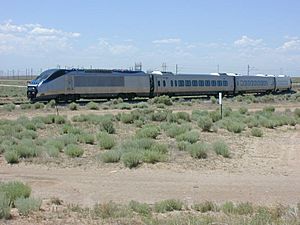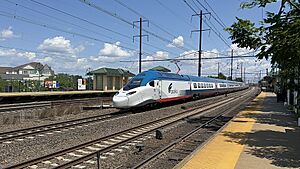Acela facts for kids
 |
|||||
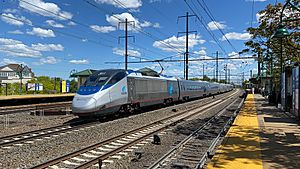
Acela at Rahway, New Jersey, in May 2021
|
|||||
| Overview | |||||
|---|---|---|---|---|---|
| Service type | Inter-city, high speed tilting train | ||||
| Locale | Northeast megalopolis | ||||
| Predecessor | Metroliner | ||||
| First service | December 11, 2000 | ||||
| Current operator(s) | Amtrak | ||||
| Annual ridership | 2,144,369 (FY22) |
||||
| Route | |||||
| Start | Boston, Massachusetts | ||||
| Stops | 12 | ||||
| End | Washington, D.C. | ||||
| Distance travelled | 457 miles (735 km) | ||||
| Average journey time | 6 3⁄4 hours | ||||
| Service frequency | 20 per day | ||||
| Train number(s) | 2100–2290 | ||||
| On-board services | |||||
| Class(es) | First Class Business Class |
||||
| Disabled access | Fully accessible | ||||
| Seating arrangements | 4 across in business class 3 across in first class |
||||
| Catering facilities | Café; at-seat meals in first class | ||||
| Baggage facilities | Racks and overhead bins; no checked luggage | ||||
| Technical | |||||
| Rolling stock | Acela Express (trainset) | ||||
| Track gauge | 4 ft 8 1⁄2 in (1,435 mm) standard gauge | ||||
| Operating speed | 150 mph (240 km/h) (top) 70 mph (110 km/h) (avg.) |
||||
|
|||||
The Acela (pronounced "uh-SEL-uh") is Amtrak's fastest passenger train service. It runs along the Northeast Corridor in the Northeastern United States. This route connects major cities like Washington, D.C., Baltimore, New York City, Philadelphia, and Boston.
Acela trains are the quickest in the Americas. They can reach speeds of 150 miles per hour (240 km/h) in some areas. However, they only travel at these top speeds for about 40 miles (64 km) of the 457-mile (735 km) route.
In 2023, over 3.2 million people rode the Acela. This made it Amtrak's second most popular train. The Northeast Regional train carried even more passengers. Acela earned about $531 million in 2024. This was about 21% of all of Amtrak's earnings.
Acela trains use special "tilting" technology. This helps the train lean into curves. It allows the train to go faster on sharp turns without making passengers uncomfortable. Most of the high-speed travel happens between New York City and Washington, D.C. This part of the trip takes about 2 hours and 45 minutes.
Between New York and Washington, Acela and the Northeast Regional trains are very popular. In 2021, they carried 83% of all people traveling between these two cities. This was a big jump from 37% in 2000.
The Acela is slower on the northern part of its route. This is because of other train traffic and older tracks. The trip from Boston to New York takes about 3 hours and 30 minutes. For the whole 457-mile (735 km) route from Boston to Washington, it takes about 6 hours and 45 minutes.
New Avelia Liberty trains are replacing the current Acela trains. These new trains started passenger service on August 28, 2025. They have more seats and an improved tilting system. This will allow them to go even faster on curved parts of the track.
Contents
History of the Acela Train
Early High-Speed Train Ideas
After Japan's fast Shinkansen trains became popular, the U.S. government wanted to explore high-speed rail. In 1965, a law was passed to look into this. This led to the Metroliner trains, which ran between Washington, D.C., and New York City starting in 1969. The Metroliner was a first step towards Acela.
In the early 1990s, Amtrak tested different high-speed trains from Europe. They leased an X 2000 train from Sweden for testing. A German ICE 1 train also toured North America and ran on the Northeast Corridor. These tests helped Amtrak decide what kind of high-speed train they wanted.
Building the Acela Fleet
After testing, Amtrak decided what features their new high-speed trains needed. In 1994, they asked train makers to bid on building trains that could go 150 miles per hour (240 km/h). A group of companies, Bombardier and Alstom, won the contract in 1996.
On March 9, 1999, Amtrak announced its plan for the Acela Express. This new high-speed train would run between Washington, D.C., and Boston. To make the route ready, Amtrak extended the electric power lines all the way to Boston. Before 2000, trains going to Boston had to switch to diesel engines in New Haven. Many railroad crossings were also improved or removed for safety.
A test train was finished in early 2000. It was sent to a special testing center in June 2000. The first special trip for VIPs happened on November 16, 2000. The first regular passenger trip for Acela was on December 11, 2000.
How Much Acela Cost
Amtrak first agreed to pay $800 million for 20 Acela trainsets. Each trainset had six passenger cars and two power cars. By 2004, Amtrak paid a total of $1.2 billion. This included the 20 trainsets, plus 15 extra high-speed engines. It also covered building new maintenance centers in Boston, New York, and Washington.
Acela's Impact on Travel
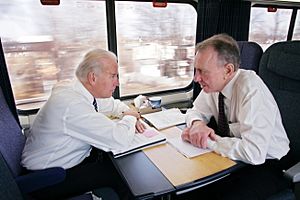
By 2005, Amtrak's share of travelers between New York and Boston grew a lot. It went from 18% before Acela to 40%. Because Acela was so popular, the older Metroliner service was stopped in late 2006. Amtrak added more Acela trips in September 2005 to meet the demand. By 2008, the trains were often crowded.
In 2011, Amtrak considered replacing or upgrading the Acela fleet. They first planned to add two more coaches to each train. This would make the trains longer and hold more passengers. However, this plan was canceled in 2012. Instead, Amtrak decided to replace the entire Acela fleet with new trains.
In 2014, Amtrak asked companies to propose new Acela trainsets. They wanted 28 or more new trains.
How the Acela Got Its Name
Before Acela, there were many different train names on the Northeast Corridor. These included Metroliners, Clockers, Empire Service, and NortheastDirect.
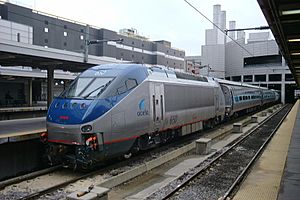
The name "Acela" was announced on March 9, 1999. The name was chosen to sound like "acceleration" and "excellence." At the same time, Amtrak tried to rename other trains. They called the NortheastDirect trains "Acela Regional" and the Clocker trains "Acela Commuter."
The "Acela Regional" name was first used on January 31, 2000. These were the first electric trains to run the full route between Washington, D.C., and Boston. As more trains became electric, they also got the "Acela Regional" name.
However, passengers got confused between the different "Acela" services. So, in 2003, Amtrak removed the "Acela Regional" and "Acela Commuter" names.
On September 23, 2019, Amtrak shortened the name from Acela Express to just Acela. Amtrak also started the Acela Nonstop service. This was a direct train from Washington, D.C., to New York's Penn Station. This nonstop service was stopped on March 10, 2020, because fewer people were riding due to the COVID-19 pandemic.
How Acela Trains Are Built
First-Generation Acela Trains
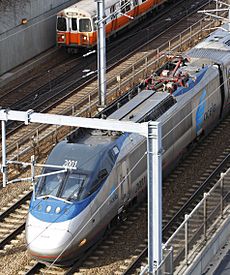
The first Acela trains were specially designed to meet U.S. safety rules. These rules included being able to survive a crash with a freight train. Many train makers found it hard to meet these tough rules. In the end, only three companies could bid on the project.
The Acela design uses powerful engines at each end of the train. These engines get power from overhead lines. The train uses some parts from the French TGV high-speed train. This includes the motors and braking system.
The passenger cars can tilt, which helps with curves. This tilting system is based on Bombardier's older LRC trains. Acela power cars and passenger cars are much heavier than TGV trains. This is because they had to meet the U.S. crash safety standards. The extra weight means Acela trains are not as powerful for their size compared to TGV trains. The safety rules also meant the passenger cars could only serve stations with high platforms. Acela trains are linked together in a special way, but they are not like the TGV's connected cars.
Second-Generation Acela Trains
On August 26, 2016, a large federal loan was announced. This money was for new Acela equipment and upgrades to the Northeast Corridor. The loans paid for 28 new Avelia Liberty trainsets. These trains were built by Alstom in New York. They replaced the original 20 Acela trains.
The new trains are longer and have more seats. They have 386 seats, which is 27% more than the old trains. They also have an improved active tilt system. This allows them to go faster on curved tracks. The new trains started passenger service on August 28, 2025.
How Fast Acela Trains Go
The first Acela trains could go up to 165 mph (266 km/h). The new Avelia Liberty trains are designed to reach 220 mph (354 km/h). However, the tracks on the Northeast Corridor limit how fast they can actually go.
The fastest speed allowed on the Northeast Corridor is 150 mph (240 km/h). This speed is reached on about 49.9 miles (80.3 km) of the 457-mile (735 km) route. This happens in parts of Rhode Island, Massachusetts, and New Jersey. The Acela averages about 90 mph (140 km/h) between Washington and New York. From New York to Boston, the average speed is about 66 mph (106 km/h). The average speed for the whole route is about 70.3 mph (113 km/h).
Speeds are limited because the route goes through cities. There are also many old bridges and tunnels that require slower speeds. Amtrak has found 224 bridges on the Acela route that are very old.
South of the Delaware River, Acela trains can only go up to 135 mph (217 km/h). This is because the overhead power system is older. In 2022, passenger trains started going 150 mph (241 km/h) in some parts of New Jersey. This was after upgrades to the tracks and signals. This section of track holds the record for the fastest speed by a train in the U.S. A test train reached 170.8 mph (274.9 km/h) here in 1967.
North of New York City, Amtrak upgraded the tracks in Connecticut. This allowed speeds over 110 mph (177 km/h). However, the slowest part of the route is between New Rochelle, New York, and New Haven, Connecticut. This section is used by many commuter trains, which limits Acela's speed.
In 2007, Amtrak tried a limited-stop trip between New York and Washington. This cut the travel time to 2 hours and 35 minutes. This was an experiment to make Acela faster, but Amtrak later stopped these specific trains.
High-Speed Track Features
The Northeast Corridor is very busy because many people live in the region. Two-thirds of all U.S. train passengers live near New York City. To compete with airplanes, Amtrak needed faster trains. The tracks from New Haven to Boston had sharp turns and railroad crossings. These crossings were a big safety concern.
Tilting technology helps passengers feel more comfortable on curves. Acela trains tilt when going over 60 mph (97 km/h). However, some tracks are too close together for the trains to tilt fully. This is to keep a safe distance between trains on parallel tracks. The original tilt system was designed for a 6.8° tilt. But the cars were made wider for more seats, which reduced the tilt to 4.2°. This was to fit within the existing tracks.
Acela service was supposed to start in late 1999 but was delayed. The power system between Washington D.C. and New York City could not support the planned speeds. The newer system between New York City and Boston allows higher speeds. The first Acela service began on December 11, 2000, a year late.
Acela travels between Boston and New York in about three and a half hours. The trip from New York to Washington takes at least two hours and forty-five minutes. These faster times, along with the convenience of downtown-to-downtown travel, made Acela more popular than flying. After the September 11 attacks, more people chose trains. Because of this competition, Southwest Airlines stopped flying between Washington and New York.
Safety at Stations
Acela trains pass through local stations very quickly. This has raised concerns about safety for passengers waiting for other trains. People worry that the yellow lines on platforms might not keep people far enough away. At some stations, Acela trains pass at 150 mph (241 km/h). Some suggestions include safety barriers or different announcements for fast Acela trains.
Train Service Interruptions
In August 2002, soon after Acela trains started running, they were briefly taken out of service. Cracks were found in parts that connected the train's shock absorbers. The trains returned to service after frequent inspections began. The cracked parts were later redesigned and replaced.
On April 15, 2005, Acela trains were again taken out of service. Cracks were found in the brake discs of many passenger cars. The companies that built the trains replaced the discs for free. Limited service started again in July 2005. The older Metroliner trains helped fill in during this time. By September 21, 2005, all 20 Acela trainsets were back in full operation.
In October 2012, Acela service was canceled because of Hurricane Sandy. The hurricane damaged tunnels, causing delays and problems for a long time.
In March 2020, all Acela trips were stopped. This was part of a plan to reduce service due to the COVID-19 pandemic in the United States. Amtrak started Acela service again on June 1, 2020.
Acela Train Features
Train Car Layout
The Acela train has two power cars, one at each end. It also has a Café car, one First Class car, and four Business Class cars. These cars are linked together. The train has fewer seats than other regional trains.
| Car no. | 1 | 2 | 3 | 4 | 5 | 6 | Total | ||
|---|---|---|---|---|---|---|---|---|---|
| Designation | Power | First Class | Business Class (quiet car) |
Business Class | Café | Business Class | Business Class (end car) |
Power | |
| Weight (US ton) | 102.0 | 71.0 | 69.5 | 69.5 | 68.5 | 69.5 | 71.0 | 102.0 | 623.0 |
| Weight (Long ton, Metric ton) |
91.1 long tons; 92.5 t | 63.4 long tons; 64.4 t | 62.1 long tons; 63.0 t | 62.1 long tons; 63.0 t | 61.2 long tons; 62.1 t | 62.1 long tons; 63.0 t | 63.4 long tons; 64.4 t | 91.1 long tons; 92.5 t | 556.2 long tons; 565.2 t |
| Capacity | — | 44 | 65 | 65 | — | 65 | 65 | — | 304 |
The First Class car has 44 seats. These seats are arranged with one seat on one side and two on the other. There are also tables with four seats. Passengers in First Class have assigned seats. There are 260 Business Class seats on each train. These cars have two seats on each side, and also four-seat tables. Business Class passengers also have assigned seats.
You can store your bags in overhead bins or under your seat. All Acela trains are designed to be accessible for people using wheelchairs. Each car has one or two restrooms, and at least one is designed for accessibility.
The Business Class car next to First Class is a "quiet car." In this car, passengers are asked to keep their voices down and avoid phone calls. Automatic sliding doors between cars help reduce noise.
Train Operations and Staff
Acela offers two types of seating: Business Class and First Class. Unlike most other Amtrak trains, Business Class is the standard option on Acela. There is no regular coach service.
Acela trains are usually maintained at special facilities. These are located in Washington, D.C., Queens, New York, and Boston.
Between 2009 and 2010, Acela trains got minor updates. This included new blue leather seats throughout the train. In May 2018, Amtrak announced another program to refresh the train interiors. This included new seat cushions, covers, and carpets. This update was finished by June 2019.
Wi-Fi Service on Acela
Wireless Internet service started on Acela trains in 2004. By 2010, all Acela trains offered "AmtrakConnect" Wi-Fi. In 2016, Amtrak upgraded to a faster Wi-Fi service.
Train Crew
Amtrak train crews usually include an engineer, a conductor, and at least one assistant conductor. Acela trains also have a special On-Board Service crew. This crew includes two First Class attendants and a Café Car attendant. Besides the food in the Café Car, an attendant often brings refreshments to passengers' seats. First Class passengers always get meals served at their seats.
Notable Acela Incidents
- During the Northeast blackout of 2003, an Acela train was stuck on the Hell Gate Bridge for over nine hours. A rescue engine eventually pulled the train back to New York's Penn Station.
- The first Acela accident at a railroad crossing happened on September 27, 2005. A car drove under closed crossing gates in Waterford, Connecticut, and was hit by a train going 70 miles per hour (110 km/h). Three people in the car died. None of the 130 Acela passengers were hurt. The crossing gates were working correctly.
- On March 24, 2017, an Acela train went off the tracks at low speed in New York's Penn Station. This happened during morning rush hour. All 248 passengers were safely taken off the train. The derailment was caused by a faulty section of track that Amtrak knew about but had not fixed yet.
- On February 6, 2018, Acela train No. 2150 separated between the first and second cars. This happened while the train was going 124 mph (200 km/h) near Havre de Grace, Maryland. No one was hurt among the crew or the 52 passengers. They were moved to another train.
Acela Station Stops
| State | Town/City | Station | Connections |
|---|---|---|---|
| Massachusetts | Boston | South Station | |
| Back Bay | |||
| Westwood | Route 128 | ||
| Rhode Island | Providence | Providence | |
| Connecticut | New Haven | Union Station | |
| Stamford | Stamford | ||
| New York | New York | New York Penn Station |
|
| New Jersey | Newark | Newark Penn Station |
|
| Iselin | Metropark | ||
| Pennsylvania | Philadelphia | 30th Street Station |
|
| Delaware | Wilmington | Wilmington | |
| Maryland | Baltimore | Baltimore Penn Station |
|
| BWI Airport |
|||
| District of Columbia | Washington | Washington Union Station |
Some Acela trains used to stop at New Rochelle, New York; New London, Connecticut; and Trenton, New Jersey. However, these stops were removed between 2021 and 2023.
See also
 In Spanish: Acela para niños
In Spanish: Acela para niños
- List of high-speed trains
- List of Amtrak routes


